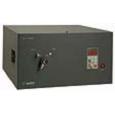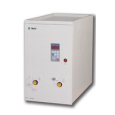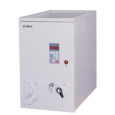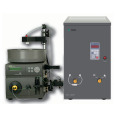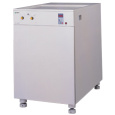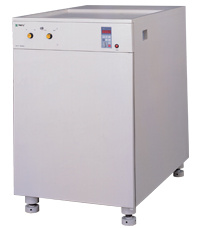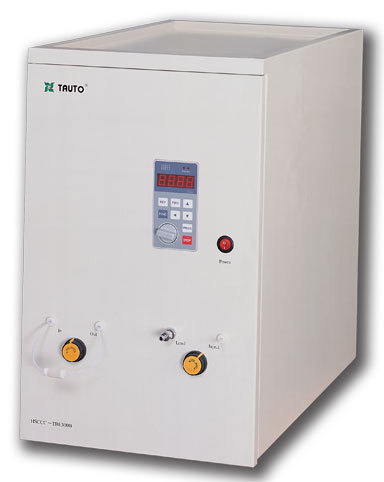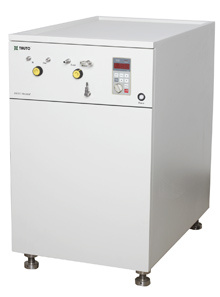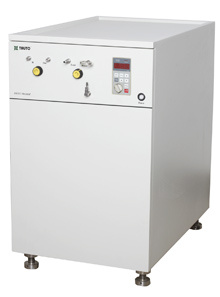方案详情
文
Abstract:Pseudostellarin B (cyclic peptide) was isolated and purified from the herbs of Pseudostellaria heterophylla (Miq.) Pax for the first time by high-speed counter-current chromatography (HSCCC) using a two-phase solvent system consisting of n-butanol–ethyl acetate–water (0.6:4.4:5,v/v).The technique can isolate mg levels of the target compound per run with purity better than 96%. The chemical structure of the compound has been positively confirmed by electrospray ionization time of flight (TOF) MS,H-NMR,C-NMR and H-C COSY analyses.
方案详情

+ModelARTICLE IN PRESSAvailable online at www.sciencedirect.comTalanta xxx (2006) xxx-xxx + ModelARTICLE IN PRESSC. Han et al./ Talanta xxx (2006) xxx-xxx2 TAL-8517;INo. of Pages 5 ELSEVIER www.elsevier.com/locate/talanta Isolation and purification of Pseudostellarin B (cyclic peptide) fromPseudostellaria heterophylla (Miq.) Pax by high-speedcounter-current chromatography Chao Han, Junhui Chen b.c, Jie Liu, Frank Sen-Chun Lee, Xiaoru Wang a,c,* Department of Chemistry and the Key Laboratory of Analytical Science of the MOE, College of Chemistry and Chemical Engineering Xiamen University, Xiamen 361005, China ' College of Chemistry and Chemical Engineering, Ocean University of China, Qingdao 266003, ChinaQingdao Key Lab of Analytical Technology Development and Standardization of Chinese Medicines, First InstituteOceanography of SOA, Qingdao 266061, China Received 3 April 2006; received in revised form 11 May 2006; accepted 15 May 2006 Abstract Pseudostellarin B (cyclic peptide) was isolated and purified from the herbs of Pseudostellaria heterophylla (Miq.) Pax for the first time byhigh-speed counter-current chromatography (HSCCC) using a two-phase solvent system consisting of n-butanol-ethyl acetate-water (0.6:4.4:5,v/v). The technique can isolate mg levels of the target compound per run with purity better than 96%. The chemical structure of the compound hasbeen positively confirmed by electrospray ionization time of flight (TOF)MS,'H-NMR,13C-NMR and H-13C-COSY analyses. 2006 Elsevier B.V. All rights reserved. Keywords: Pseudostellaria heterophylla (Miq.) Pax;HSCCC; Pseudostellarin B; Preparative chromatography 1. Introduction Pseudostellaria heterophylla (Miq.) Pax, or Taizishen hasbeen used as a traditional Chinese medicine for over 1000 years.The herb is frequently used to treat diseases such as lung andspleen tonic [1]. Cyclic peptides extracted from P. heterophylla(Miq.) Pax have been a subject of considerable interest becausemany individual species in this compound class exhibited potentinhibitory activities towards tyrosinase and melanin production[2-4]. The preparative separation and purification of cyclic pep-tides from many plants by conventional methods are tedious andusually require repeated chromatographic steps on a silica gelcolumn [2-4]. The overall yield of this method is usually poorbecause the target species tend to strongly adsorbed onto thesolid support during separation. High-speed counter-current chromatography (HSCCC) is asupport-free all liquid chromatographic technique that has beensuccessfully applied to the separation and isolation of many nat- ( * Corresponding a uthor. Tel.:+86 532 88963253; fax: +86 532 88963253.E-mail address: m t2elp@ fio .org. c n ( X. W a ng). ) ( 0039-9140/$ -se e fr o nt m a tter @ 2006 El s evier B.V. All r i ghts reserved.doi: 1 0. 1 016 / j. ta l a nta.2 0 0 6. 05 . 016 ) ural products [5-11]. It relies on the use of centrifugal forcefor the retention of the liquid stationary phase, which is con-tinuously eluted by the counter-flowing mobile phase driven byexternal pumping [12]. Compared to other liquid-liquid tech-niques,HSCCC is advantageous because of its shorter separationtime, wider range of selection of solvent systems and quantita-tive material recovery In this paper, the development of HSCCC method for the sep-aration and purification of Pseudostellarin B (a cyclic peptide)from the crude extract of P. heterophylla (Miq.) Pax will bedescribed. The chemical structure of the compound was elu-cidated by electrospray ionization time of flight (TOF) MS,H-NMR,13C-NMR and H-13C-COSY analyses. 2. Experimental 2.1. Materials Dried P. heterophylla (Miq.) Pax roots, whose species wasidentified by Mr. Wenshen Wang (B&C Technology Inc., Xia-men, China) according to morphological characteristics. Acetonitrile is of chromatographically grade and purchasedfrom Sigma. The water used in mobile phase mixtures wastreated with a Milli-Q water purification system (Millipore, Mol-sheim, France). All organic solvents used for HSCCC were ofanalytical grade and purchased from Shanghai chemical reagentcorporation, Shanghai, China. 2.2. Preparation of the crude extract of P. heterophylla(Miq.) Pax Roots of died P. heterophylla (Miq.)Pax (400 g), were milledto powder (ca. 60 mesh) by a disintegrator made in HangzhouChunjiang Pharmacy Machine Co. It was extracted three times(3x 45 min), each with 2000 ml of methanol by sonication usinga SK3200LH ultrasonic cleaning instrument (Shanghai KudosUltrasonic Instrument Co., Shanghai, China). The combinedmethanolic extract was evaporated to dryness under vacuumwith a Model SENCO R-201 rotary evaporator (Shanghai Shen-sheng Biotech Co.,Shanghai, China). The dried residue obtainedwas then dissolved in 400 ml of water. The aqueous solutionwas placed in a funnel, and was extracted three times each with300 ml of anhydrous ethyl ether, and then the aqueous solutionwas extracted three times each with 300 ml of water-saturatedbutanol. The combined butanolic extract was evaporated to dry-ness under vacuum at 50°C to obtain the crude extract of P.heterophylla (Miq.) Pax. The crude extract was further purifiedby LSA-20 macroporous resin (Xi'an Lanshen Technology Cor-poration, Xi’an China). The fraction obtained by ethanol-water(3:2, v/v) elution was concentrated under reduced pressure andfreeze-dried with a LABCONCO freeze dry system (USA) toyielded 1835 mg of the crude extract. The crude extract wasstored at -4°C before HSCCC separation. 2.3. High-speedcounter-current chromatography (HSCCC) 2.3.1. Instrumentation HSCCC was performed with a Model TBE-300A HSCCCsystem manufactured by Tauto Biotech Co. Ltd., Shanghai,China. The multi-layer coil planet centrifuge was prepared bywinding 1.8 mm i.d. PTFE tubing coaxially onto the columnholder with a total capacity of 350 ml. The p-value varied from0.42 at the internal terminal to 0.63 at the external terminal.β=r/R, where r is the distant from the coil to the holder shaftand R is the revolution radius or the distant between the holderaxis and central axis of the centrifuge. The rotation speed isadjustable from 500 to 1000 rpm; and 800 rpm was used in thepresent study. The constant temperature control in this systemwas performed by a constant temperature circulating implementwith the aim to eliminate the harmful effect of temperature vari-ation on separation efficiency. The solvent was pumped into the column with a Model S1007constant-flow pump (Beijing Shengyitong Technology Devel-opment, Beijing, China). The effluent was detected on-line at213 nm with a Model 8823A UV detector (Beijing Institute ofNew Technology Application). A manual sample injection valvewith a 20 ml loop was used to introduce the sample into the col-umn. A Model 3057 portable recorder (Sichuan Instrument Fac- tory, Chongqing, China) was used to record the chromatogram.Moreover, the data was also displayed and analysed simulta-neously on a Model Sepu 3000 chromatographic data stationprovided by Hangzhou Puhui Scientific Technology. 2.3.2. HSCCC separation procedure A mixture of n-butanol-ethyl acetate-water (0.6:4.4:5, v/v)was shaken vigorously in a separatory funnel and let stand atroom temperature until there were two clearly separated phases.The two-phases were then used in the HSCCC after they reachedequilibrium. The multi-layer coiled column was first filled com-pletely with the upper layer solvent which serves as the stationaryphase, then the lower layer (mobile phase) was pumped into headend of the column at a flow-rate of 1.6 ml/min while the columnwas rotating at 800 rpm. A sample (60 mg) dissolved in 8mlof the upper phase was loaded into the injection valve after thesystem reached hydrodynamic equilibrium. The column effluentwas monitored with a UV detector at 213 nm as stated earlier,and each peak fraction was collected manually according to thechromatographic profile displayed on the recorder. 2.4. High-performance liquid chromatography conditions An Agilent Technology 1100 Series HPLC system equippedwith a quaternary pump, a degasser, a thermostatic auto-samplerand a photodiode array detector (DAD), was used for the analysisof Pseudostellarin B in the crude extract and fractions collectedfrom the HSCCC separation. The analysis was carried out witha SinoChrom ODS-BP C18 column (4.6mm×200 mm, 5 pm,Dalian Elite Analytical Instruments). The binary mobile phaseconsisted of acetonitrile and pure water. All solvents were fil-tered through a 0.45 pm filter prior to use. The flow-rate was keptconstant at 1.0 ml/min for a total run time of 40 min. The percent-age of acetonitrile in the mobile phase was programmed as fol-lows: 2% (0 min)-10% (10 min)-45% (30min)-55% (40 min).Elution was monitored at 213 nm by a DAD detector. The purityof the isolated constituent was determined based on the peakarea normalized to all observed HPLC peak area. 2.5. ESI-TOF-MS for identification The MS instrument used to perform the studies was an elec-trospray ionization time of flight mass spectrometer AgilentMSD TOF (Agilent Technologies), using the operational param-eters included in Table 1. The data recorded was processedwith the Applied Biosystems/MDS-SCIEX AnalystQS software(Frankfurt, Germany) with accurate mass application specificadditions from Agilent MSD TOF software. A second orthogo-nal sprayer with a reference solution was used as a continuouscalibration using the following reference masses: 121.0509 and922.0098 m/z. Spectra were acquired over the m/z 100-2000range at a scan rate of 1s per spectrum. 2.6. NMR for identification The H-NMR,13C-NMR,and'H-13C-COSY spectra wererecorded on a Bruker 500 MHz nuclear magnetic resonance Table 1TOF-MS operational parameters in positive ESI ion mode Parameter Value Capillary voltage 3500 V Nebulizer pressure 45 psig Drying gas 121/min Gas temperature 350°C Fragmentor voltage 200 V Skimmer voltage 60V Mass range (m/z) 100-2000 Resolution 9500±500 (922.0098) Reference masses 121.0509,922.0098 spectrometer (Bruker BioSpin Ltd.,Canada). TMS was an inter-nal standard. Approximately 8 mg of the purified compound wasdissolved in 500 pl of pyridine-ds in NMR measurement. 3.Results and discussion 3.1. HSCCC separation of Pseudostellarin B from thecrude extract In a HSCCC experiment, selection of the two-phase solventsystem is the first and critical step; a good solvent system can pro-vide an ideal partition coefficient (K) for the target compounds.The key of solvent optimization is first to find a solvent combi-nation in which the samples is freely soluble, then to adjust thissolvent combination to ensure that the K value of the target com-pounds is close to 1 [13,14]. The K value of a two-phase solventsystem is critical for efficient separation. If it is much smallerthan 1, the solutes will be eluted close to each other near the sol-vent front, which may result in loss of peak resolution; if the Kvalue is much greater than 1, the solutes will be eluted in exces-sively broad peaks, and may lead to extended elution time [5]. In our experiment, the crude Pseudostellarin B extract wasused as the testing material and five series of solvent systemsaccording to the solubility of the target compound was selected.LC was used to measure the sample concentration in each phase,from which the K values of the Pseudostellarin B were calcu-lated. The measured K values for Pseudostellarin B in thesedifferent solvent systems are summarized in Table 2. Under the conditions of 800 rpm revolution speed, 1.6 ml/minflow-rate, and 25°C coil planet centrifuge temperature, thefollowing these five solvent systems were evaluated: (1) n-butanol-ethyl acetate-acetic acid-water (0.5:4.5:0.5:6, v/v);(2)n-butanol-ethyl acetate-methanol-water (0.5:4.5:1:4, v/v); (3)n-butanol-ethyl acetate-ethanol-water (0.5:4.5:0.2:4, v/v);(4)n-butanol-ethyl acetate-ethyl ether-water (0.5:4.5:0.5:6, v/v);(5) n-butanol-ethyl acetate-water (0.6:4.4:5, v/v). The upperphases were used as the stationary phase while the lower phaseswere used as the mobile phase in all tests. 59.6%,57.3%,15.8%,77.3% and 45.2% of stationary phase retentions were obtainedfor solvent systems (1), (2), (3), (4) and (5), respectively. Based on the results of K values and stationary phase reten-tions values, two systems selected for further evaluation weren-butanol-ethyl acetate-acetic acid-water (0.5:4.5:0.5:6, v/v)and n-butanol-ethyl acetate-water (0.6:4.4:5,v/v). Table 2 The K values (partition coefficient) of Pseudostellarin B in different two-phasesolvent systems used in HSCCC Solvent system K value n-Butanol-ethyl acetate-acetic acid-water (0.5:4.5:0.5:6, v/v) 0.86 n-Butanol-ethyl acetate-methanol-water (0.5:4.5:1:4,v/v) 0.72 n-Butanol-ethyl acetate-ethanol-water (0.5:4.5:0.2:4,v/v) 0.79 n-Butanol-ethyl acetate-ethyl ether-water (0.5:4.5:0.5:6, v/v) 0.64 n-Butanol-ethyl acetate-water (0.6:4.4:5, v/v) 1.12 Experimental procedure: approximately 1 mg of the sample was weighed ina 10 ml test tube into which 2 ml of each phase of the pre-equilibrated two-phasesolvent system was added. The test tube was capped and shaken vigorously for1 min, and allowed to stand until it separated completely. An aliquot of 200 plof each layer was taken out and evaporated separately to dryness invacuo at<40°C. The residue was dissolved in 200 pl methanol and analysed by LC fordetermining the partition coefficient (K) of compound Pseudostellarin B. The Kvalue was expressed as the peak area of target compound in the upper phase vs.in the lower phase. Table 3 lists the distributions of the 10 peaks (Fig.2(A)) inthe two solvent systems of: (1) n-butanol-ethyl acetate-aceticacid-water (0.5:4.5:0.5:6,,v/v)and1(2)n-butanol-ethylacetate-water (0.6:4.4:5, v/v). In system (1), the K values ofpeak 6 compared with peaks 4 and 7 are so similar, and mayresult in poor separation. In system (2), the value of peak 6 issignificantly different from the other peaks. The K values of thepeaks 3, 7, 8 and 10 were too greater than 1, they were retainedin the CCC column and may lead to extended elution time [5].The results thus suggest that solvent system (2) is suitable for theseparation of Pseudostellarin B, as shown in Fig. 1. This solventsystem was therefore used for all later HSCCC runs. The HPLCchromatogram of a crude extract of P. heterophylla (Miq.) Paxis given in Fig. 2(A). It can be seen that the crude extract givesmany peaks among which Pseudostellarin B is the major peakThe peaks I-IV in Fig. 1 were individually collected and anal-ysed by HPLC. Peak I consists of two peaks (peaks 1 and 2) inthe HPLC chromatogram (Fig. 2(A)); Peak II consists of twopeaks (peaks 4 and 5) in the HPLC chromatogram (Fig. 2(A))Peak III in the HPLC chromatogram is peak 6 (Fig. 2(B)), in. which a clean peak of the target species is observed; Peak IV in min Fig. 1. HSCCC chromatogram of the crude extract of P. heterophylla (Miq.)Pax; solvent system: n-butanol-ethyl acetate-water (0.6:4.4:5, v/v); station-ary phase: upper phase; mobile: lower phase; flow-rate: 1.6 ml/min; revolutionspeed: 800 rpm; temperature: 25°C; sample size:60 mg extract dissolved in8 ml upper phase of solvent system; detection at 213 nm. (The fraction III werecollected from 160 to 175 min and purified to over 96% estimated by HPLCanalyses). C. Han et al. / Talanta xxx (2006)xxx-xxx Table 3Partition coefficient of 10 compounds in two solvent systems Peaks Peaks 1 2 3 4 5 6 7 8 9 10 Solvent systems 1 (1) 0.61 0.67 3.16 1.14 0.86 1.18 1.37 4.68 2.07 3.92 Solvent systems 1 (2) 0.68 0.71 4.65 0.76 0.80 1.12 3.96 5.16 2.36 4.32 Note: solvent systems:(1) n-butanol-ethyl acetate-acetic acid-water (0.5:4.5:0.5:6, v/v) and (2) n-butanol-ethyl acetate-water (0.6:4.4:5, v/v). Fig. 4. Pseudostellarin B [M+H]*isotopics compared with calculated isotopics. of the crude extract sample and the purity of Pseudostellarin B(Fig. 2(B)) estimated by HPLC analyses is 96.2%. 3.2. Identification by TOF-MS and NMR experiments Fig. 2. HPLC chromatograms of the crude sample of (A) P. heterophylla (Miq.)Pax and (B) the purified Peak III (Pseudostellarin B); column: SinoChrom ODS-BP C18 (4.6mmx200 mm, 5 pm, Dalian Elite Analytical Instruments) at roomtemperature; elution: acetonitrile and pure water, the percentage of acetonitrile inthe mobile phase was programmed as follows: 2% (0 min)-10%(10 min)-45%(30 min)-55% (40 min); flow-rate: 1.0 ml/min; detection at 213 nm. (Peak I in theHPLC chromatogram is peak 1 and peak 2; Peak II in the HPLC chromatogramis peaks 4 and 5; Peak III in the HPLC chromatogram is peak 6; Peak IV in theHPLC chromatogram is peak 9). The cyclic peptide Pseudostellarin B discussed in this paperhas been previously identified in literature report [3]. To con-firm the identity of the HSCCC peak as described above, theisolated material were collected and measured by ESI-TOF-MSand H-NMR, 13C-NMR and H-13C-COSY. The ESI-TOF-MS mass spectrum of peak 6 in the positive mode gave m/z the HPLC chromatogram (Fig. 2(A)) is peak 9. Since Peaks I,II and IV were no major peak, and the overall contents of themwere very low, no further study was therefore carried out. Theyield of Pseudostellarin B amount 3 mg (5.0%,w/w) from 60 mg Fig. 3. TOF-MS spectrum of Pseudostellarin B [M+H]+. Fig.5. The structure of Pseudostellarin B. Table 4 Exact mass measurement and elemental composition of Pseudostellarin B Compound Formula Selected ion Experimental m/z Calculated m/z DBE Error mda ppm Pseudostellarin B C33H46N8O [M+H]+ 683.3519 683.3518 15 0.1 -0.3131 683.3519 as the protonated molecular ion [M+H]+ (Fig. 3)and the m/z 705.3331 peak was sodium adduct molecular ion[M+Na]*, showed a molecular formula C33H46N8Og, indi-cating 15 degrees of unsaturation, the same as that for Pseu-dostellarin B [3]. Fig. 4 shows that theoretical isotopics of thecompound can perfectly match it of actual compound and themass error under 1 ppm (Table 4). The lH-NMR, 13c-NMRand H-3C-COSY results agree completely with the literature[3]. Based on the combined results of TOF-MS and NMR, peak6 is positively identified as Pseudostellarin B with its structuregiven in Fig. 5 .4. Conclusion HSCCC technique has been developed and successfullyapplied to the separation and purification of Pseudostellarin B incrude extract of P. heterophylla(Miq.)Pax. Combined ESI-TOF-MS and NMR analyses were employed to positively identify theisolated target species, which is a known bioactive species inP. heterophylla (Miq.) Pax. HSCCC thus provides an attractivealternative to HPLC for the semi-preparative scale separationand purification of bioactive components in herbal extracts.In previous studies in our laboratory, HSCCC has been suc-cessfully developed for the preparative separation of bioactiveflavonoids inflacoumarin A and licochalcone A from the crudeextract of Glycyrrhiza inflata Bat and salvianolic acids fromSalvia miltiorrhiza Bunge. The current study further illustratesthe effectiveness of HSCCC as a semi-preparative separationtechnique for the isolation and purification of bioactive compo-nents from herbal extracts. Acknowledgements This work was supported by National Natural Science Foundation of China (20235020), the Ministry of Science and Tech-nique of Fujian Province (2001BA701A61-13) and QingDao“2004 JiangCai Plan”(04-3-JJ-11).The authors would also liketo acknowledge the continuous support of Xiamen B&C Tech-nology Inc. References ( [1] S.H. L i , X . H. Liu, L ishizhen Med. Mater. Med. Res. 1 2 (2001) 1 99. ) [2] H. Morita, T.Kayashita, H. Kobata, A. Gonda, K. Takeya, H. Itokawa,Tetrahedron 50 (1994) 9975. [3] H. Morita, T. Kayashita, H. Kobata, A. Gonda, K. Takeya, H. Itokawa,Tetrahedron 50 (1994) 6797. [4] H. Morita, H. Kobata, K. Takeya, H. Itokawa, Tetrahedron Lett. 35(1994) 3563. ( [5] L . J. C h en, D .E. G ames, J. J o nes, J . Chromatogr. A 9 88 (20 0 3) 95. ) ( [6] H. T . Lu, Y. Jiang, F. Chen , J . Chromatogr. A 1017 (2003) 1 17. ) [7] Q. Du, G. Jerz,R. Waibel, P. Winterhalter, J. Chromatogr. A 1008(2003)173. [8] L. Li, R. Tsao, Z.Q. Liu, S.Y. Liu, H.H. Zhu, Z.Y. Deng, M.Y. Xie,Z.H. Fu,J. Chromatogr. A 1063 (2005) 161. [9] X. Wang, Y. Wang, Y. Geng, F. Li, C. Zheng, J. Chromatogr. A 1036(2004)171. [10] Q.E. Wang, F.S.C. Lee, X.R. Wang, J. Chromatogr. A 1048 (2004) 51. [11] J.H. Chen, F.M. Wang, F.S.C. Lee, X.R. Wang, M.Y. Xie, Talanta 69(2006)172. ( [ 12] D .S. Dai, Y.M. Wang, G.A. L u o, Chin. J . Anal. Chem. 5 (2001) 90. ) ( [13] H. Oka, K . H arada, Y . I to , J . Chromatogr.A 8 12 ( 1998) 3 2. ) ( [ 1 4] H. Oka, K. Harada, M. Suzuki, Y. I t o, J. C hromatogr. A 9 0 3 (2000) 93. )
确定
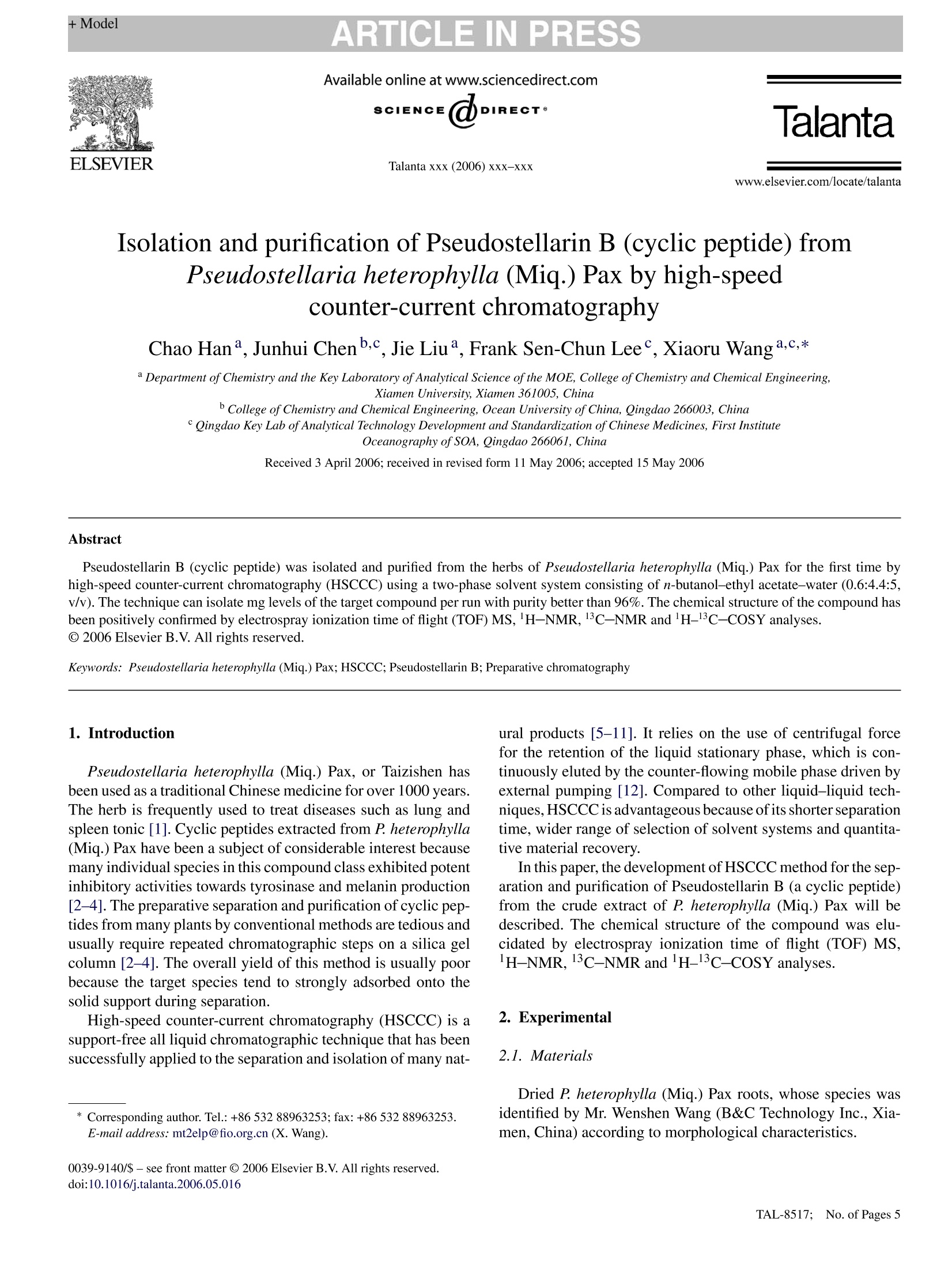
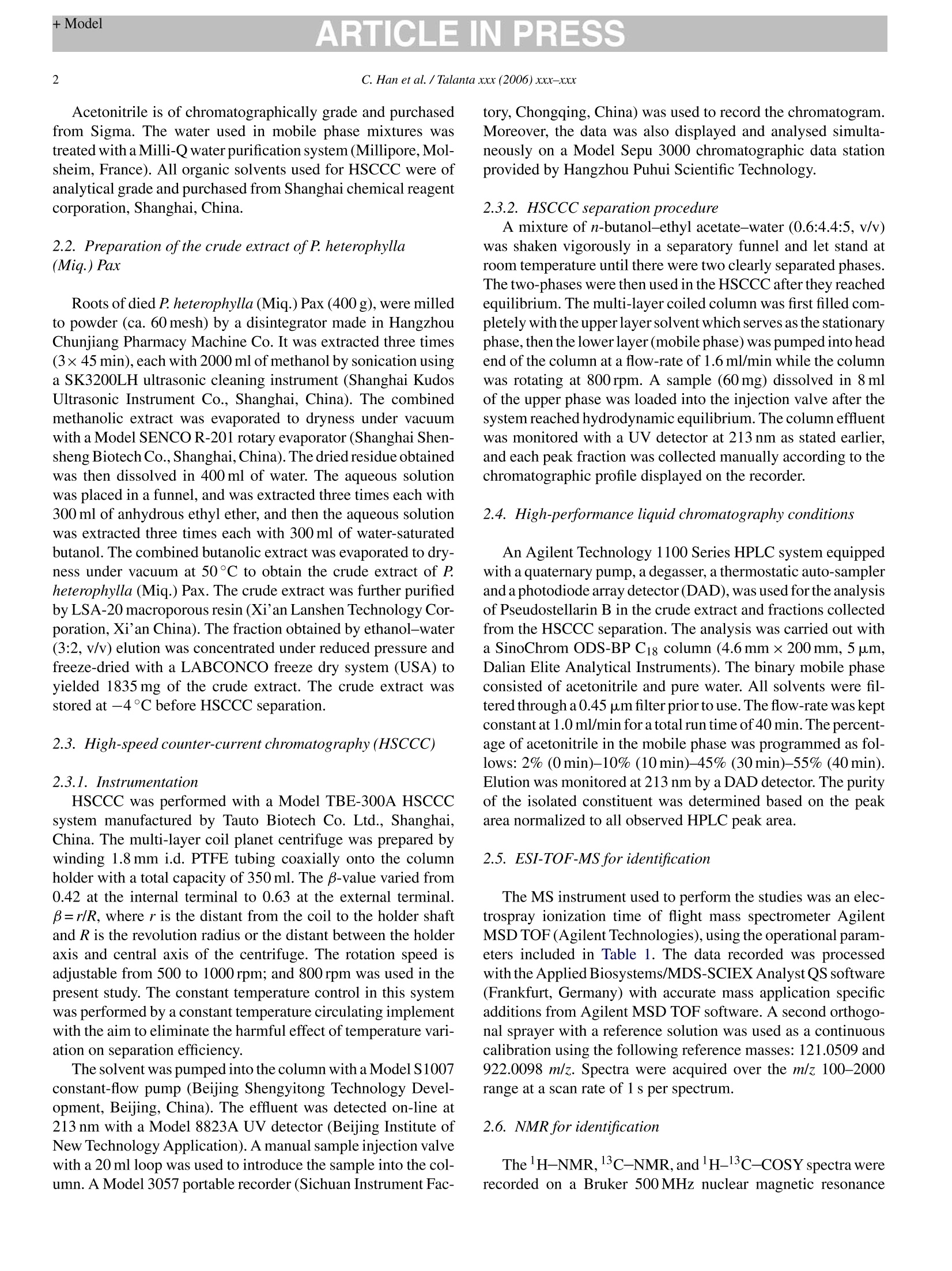
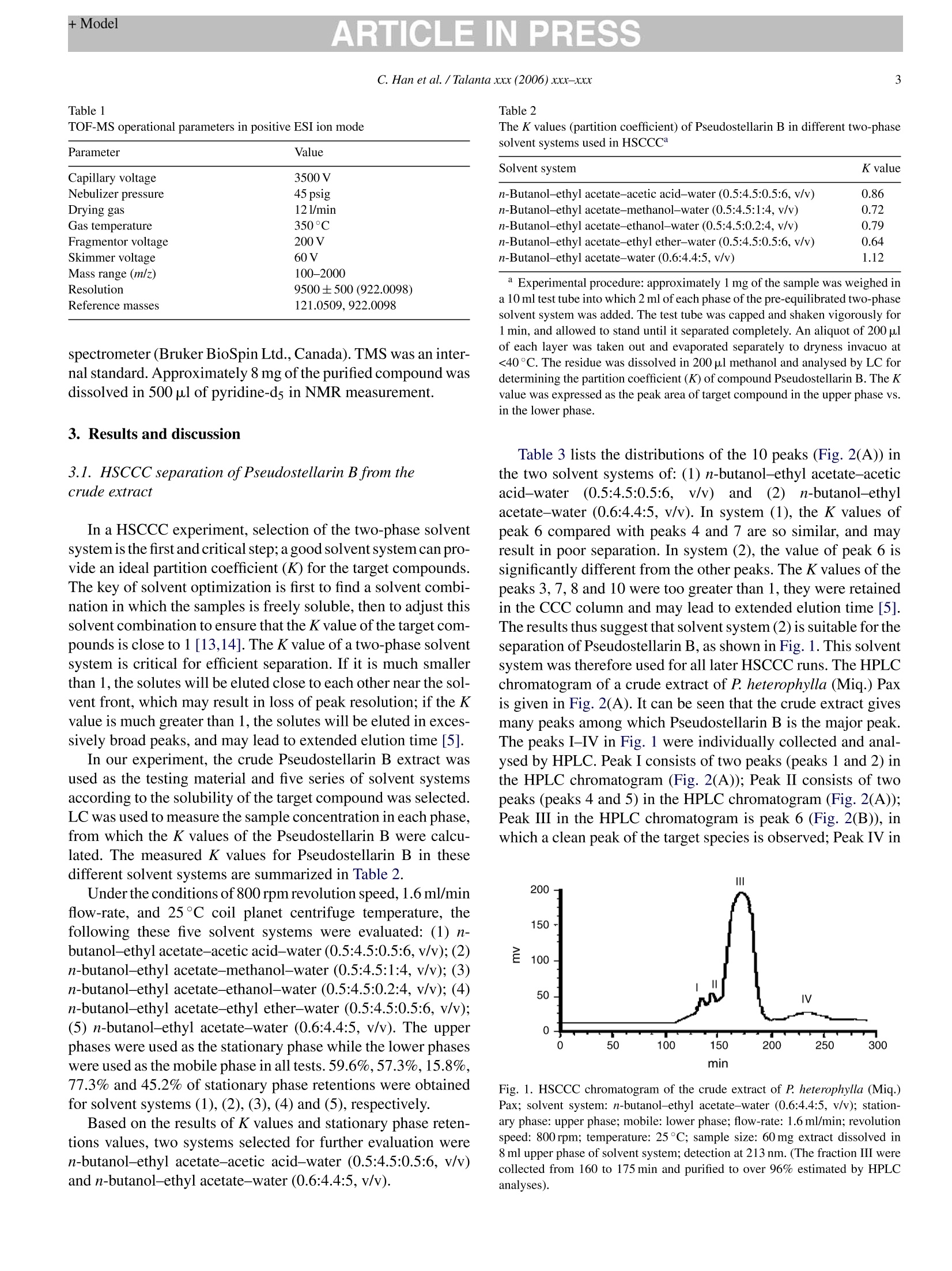
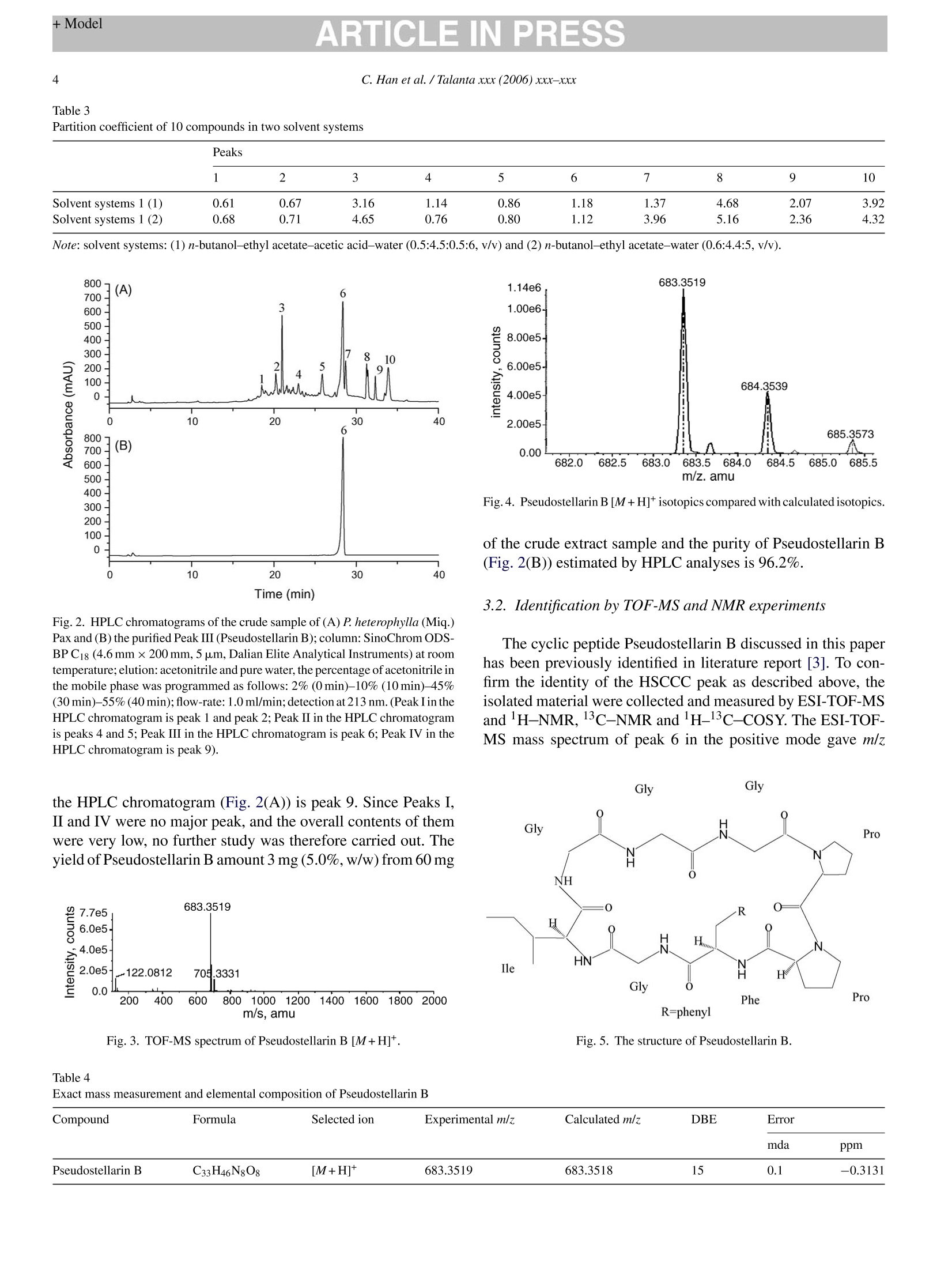
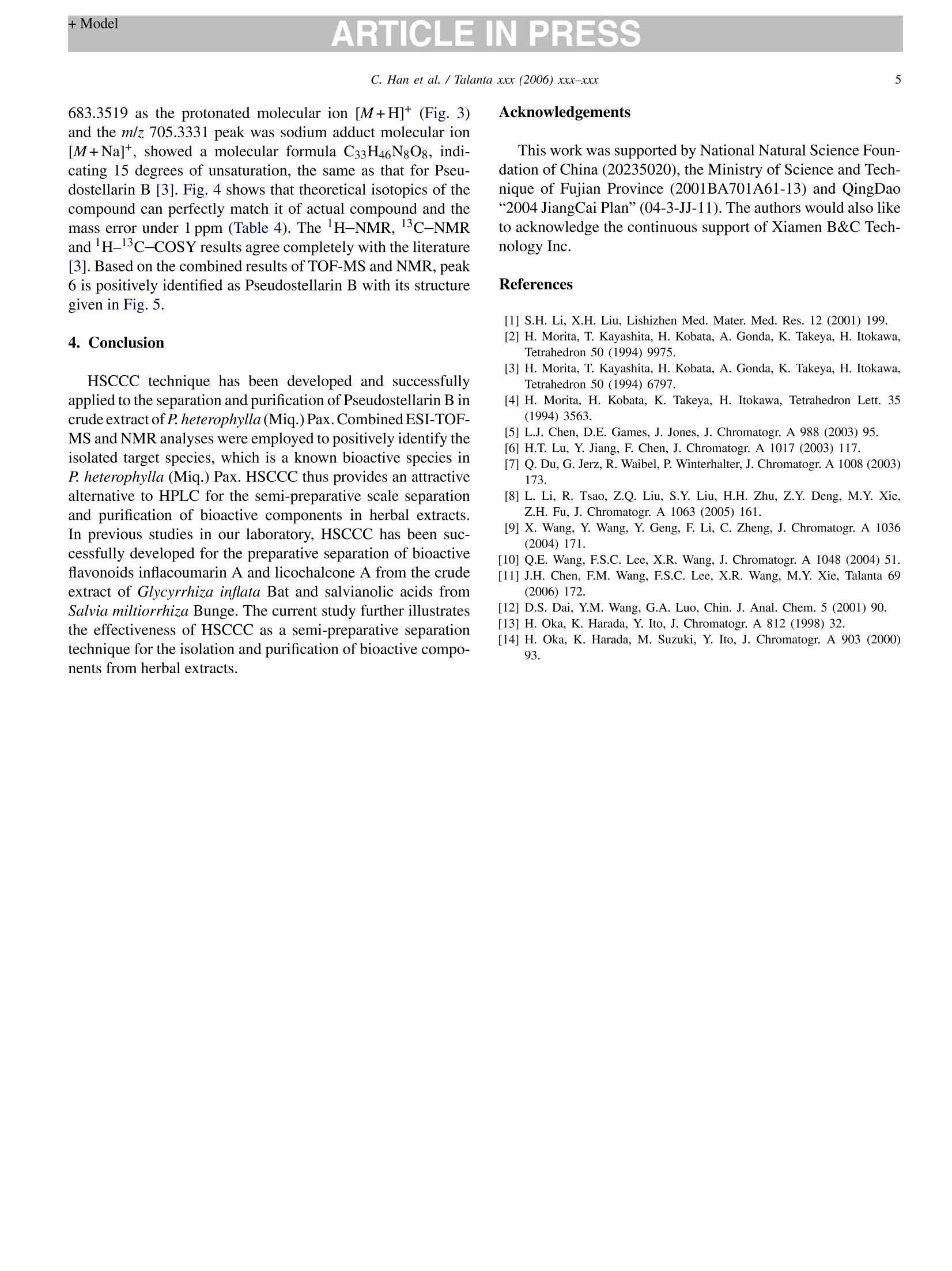
还剩3页未读,是否继续阅读?
上海同田生物技术有限公司-高速逆流色谱仪HSCCC为您提供《太子参中Pseudostellarin B检测方案(高速逆流色谱)》,该方案主要用于中药材和饮片中含量测定检测,参考标准--,《太子参中Pseudostellarin B检测方案(高速逆流色谱)》用到的仪器有TBE-300A高速逆流色谱仪/制备色谱仪、TBE-200V 高速逆流色谱仪、TBE-20A分析型高速逆流色谱仪/萃取仪/制备色谱仪、TBE300B+AKTA高速逆流色谱仪/离心分配色谱/萃取仪/制备色谱仪、TBE-1000A制备色谱仪/萃取仪/快速分离制备色谱仪
推荐专场
相关方案
更多
该厂商其他方案
更多










